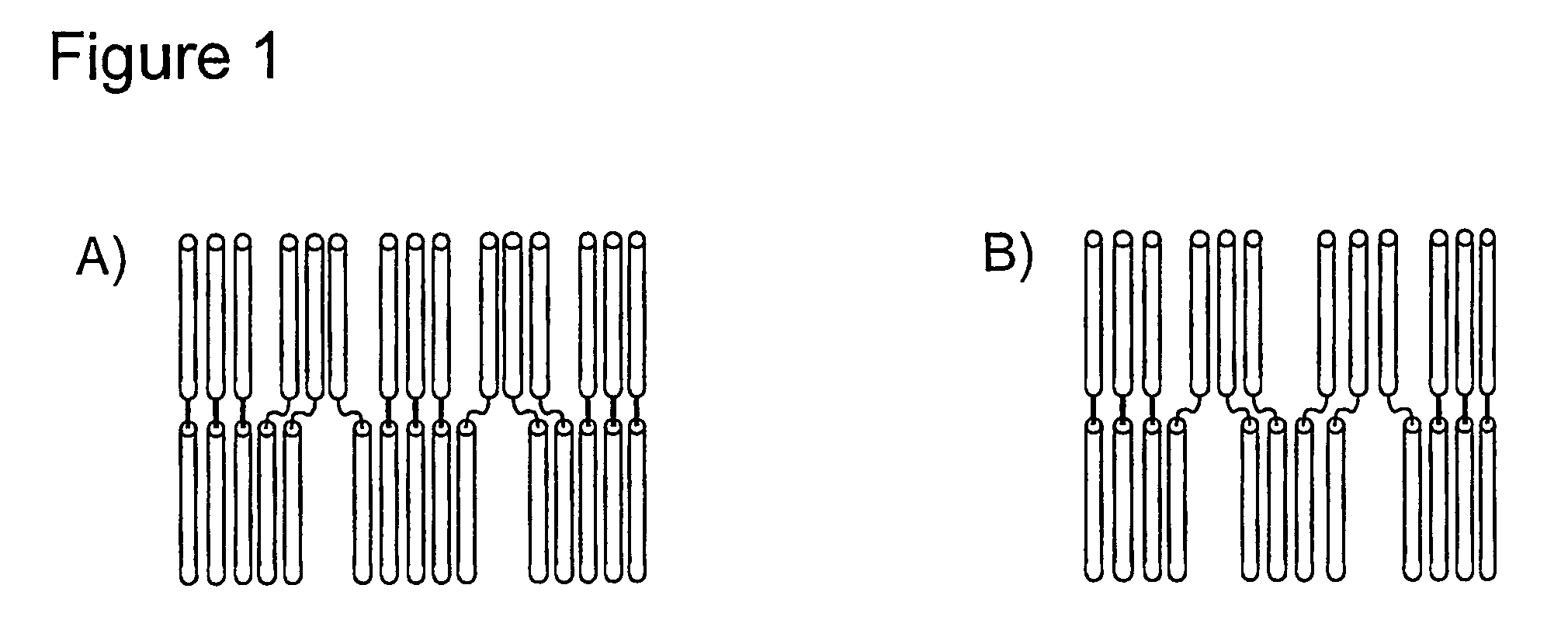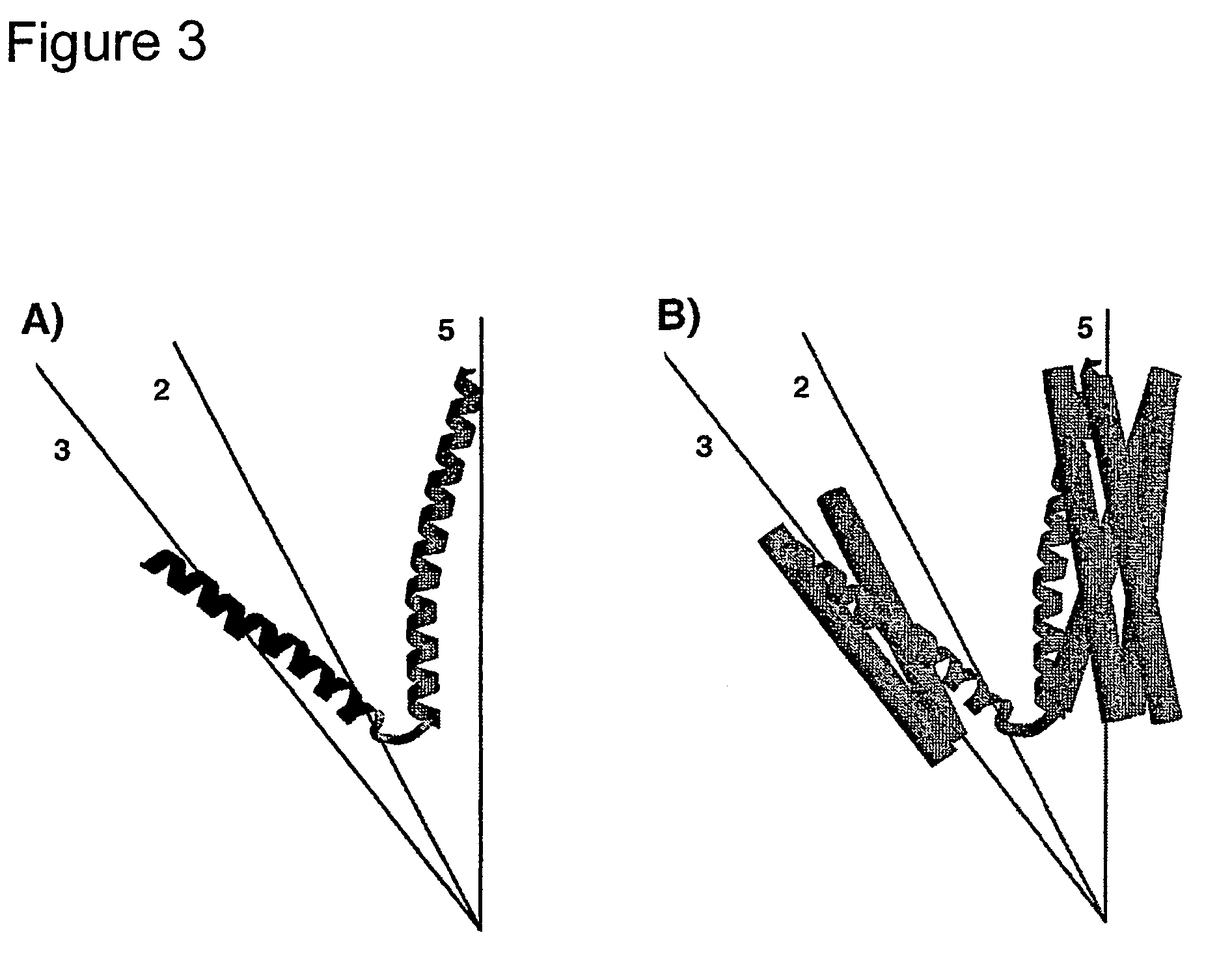Peptidic nanoparticles as drug delivery and antigen display systems
a technology of antigen display system and peptide nanoparticle, which is applied in the field of nanoparticles, can solve the problems of mechanical instability of liposomes, limited loading capacity, and complicated process for the preparation of such nanocapsules
- Summary
- Abstract
- Description
- Claims
- Application Information
AI Technical Summary
Benefits of technology
Problems solved by technology
Method used
Image
Examples
example 1
Ac-COMP—Trimer(De Novo)-NH2
[0114]A peptide of the following sequence (SEQ ID NO:1) is prepared by standard solid phase peptide synthesis (Merrifield R. B., Adv Enzymol Relat Areas Mol Biol. 1969, 32:221-296) starting the synthesis from the C-terminus.
[0115]
1 10 20 30 40Ac-DEMLRELQETNAALQDVRELLRQQVKQITFLKCLLMGGRLLCRLEEL 50 60ERRLEELERRLEELERR-NH2
[0116]This corresponds to 30 amino acids from the pentameric domain of COMP (Cartilage Oligomerization Matrix Protein) lacking the disulfide bridges at the C-terminal end and with improved N- and C-termini for stable intra- and interhelical interactions, two glycine residues as the linker segment; and 26 amino acids as a de novo designed trimeric coiled-coil domain. At the N-terminus the positively charged amino group is replaced by an acetylamino moiety, at the C-terminus the negatively charged carboxy group is replaced by a carboxamide. Residues 33 and 42 are cysteine residues; they are at aa(f) posit...
example 2
COMP—Trimer(De Novo) (No Cys)
[0135]A peptide of the following sequence (SEQ ID NO:2) is recombinantly expressed in a standard E. coli expression system using a His-tag affinity purification scheme in combination with a thrombin cleavage:
[0136]
10 20 30 40GSDEMLRELQETNAALQDVRELLRQQVKQIRRLKRLLRGGRLLAELEEL50 60RERLEELERRLEELERR
[0137]This is related to the sequence from Example 1 (SEQ ID NO:1) but with improved intra-molecular ionic interactions between the two helices of the nanoparticle (residues 31, 32, 35, 38, 45, 50, 51), lacking the intra-molecular disulfide bridge between residues 33 and 42 of Example 1 (replacement of cysteine by arginine or alanine, respectively) and starting with two additional residues (glycine and serine) from the thrombin cleavage site of the expression system.
[0138]One condition was tested for assembling nanoparticles from the monomeric building block SEQ ID NO:2: 1 mg / ml peptide is dissolved in 150 mM NaCl, 20 mM Tris, ...
example 3
Trimer(Foldon)—COMP
[0140]A peptide of the following sequence (SEQ ID NO:3) is recombinantly expressed in a standard E. coli expression system using a His-tag affinity purification scheme in combination with a thrombin cleavage:
[0141]
10 20 30 40GSGYIPEAPRDGQAYVRKDGEWVLLSTFLGGLAPQMLRELQETNAALQD50 60 70VRELLRQQVKQITFLKNTVMECDACG
[0142]This corresponds to two additional residues (glycine and serine) from the thrombin cleavage site of the expression system, 27 amino acids of the trimeric foldon domain of fibritin; two glycine residues as the linker segment; and 44 amino acids from the pentameric domain of COMP including the disulfide bridges at the C-terminal end. Residues 71 and 74 may form interhelical disulfide bridges.
[0143]Two different conditions are tested for assembling nanoparticles from the monomeric building block SEQ ID NO:3.
[0144]Preparation 1: 1 mg / ml peptide is dissolved in 150 mM NaCl, 20 mM Tris, pH 7.0.
[0145]Preparation 2: 1 mg...
PUM
| Property | Measurement | Unit |
|---|---|---|
| diameters | aaaaa | aaaaa |
| concentration | aaaaa | aaaaa |
| diameter | aaaaa | aaaaa |
Abstract
Description
Claims
Application Information
 Login to View More
Login to View More - R&D
- Intellectual Property
- Life Sciences
- Materials
- Tech Scout
- Unparalleled Data Quality
- Higher Quality Content
- 60% Fewer Hallucinations
Browse by: Latest US Patents, China's latest patents, Technical Efficacy Thesaurus, Application Domain, Technology Topic, Popular Technical Reports.
© 2025 PatSnap. All rights reserved.Legal|Privacy policy|Modern Slavery Act Transparency Statement|Sitemap|About US| Contact US: help@patsnap.com



